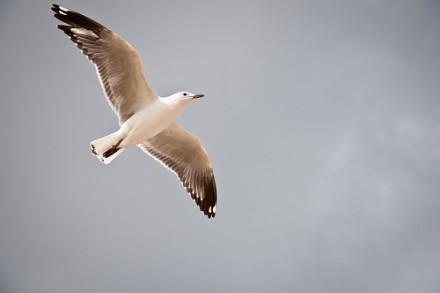Wing movement provides lift as well as the propulsion needed to overcome "drag" and to gain speed. The bird's wing movement might be compared to a swimmer's doing the "butterfly stroke." His arms rotate around his shoulder joint, as he throws them forward through the air and then pulls them back through the water. Flight, however, is far more complex, involving the rotation of the wing and the relative movements of various parts of it.
The faster the bird travels, the more lift will come from the air passing around the wings. It has been calculated that a pigeon first taking off uses five times as much energy as when it reaches steady flight.
With most larger birds, the increased wingspan is still not large enough to cope with their extra weight and greater drag, especially when taking off. So some of these, such as the pelican, run on the ground for a few feet to gain speed for lift. Others, such as the vultures, land on a tree or fence and then, by jumping off, gain enough speed through the pull of gravity for their wings to provide lift.
The heaviest bird that can fly is the trumpeter swan, weighing up to 40 pounds (18 kilograms). Heavy birds are limited in the amount of flapping they can do because of the strenuous effort involved. However, this does not restrict their ability to fly, for they are masters of another form of flight
The faster the bird travels, the more lift will come from the air passing around the wings. It has been calculated that a pigeon first taking off uses five times as much energy as when it reaches steady flight.
With most larger birds, the increased wingspan is still not large enough to cope with their extra weight and greater drag, especially when taking off. So some of these, such as the pelican, run on the ground for a few feet to gain speed for lift. Others, such as the vultures, land on a tree or fence and then, by jumping off, gain enough speed through the pull of gravity for their wings to provide lift.
The heaviest bird that can fly is the trumpeter swan, weighing up to 40 pounds (18 kilograms). Heavy birds are limited in the amount of flapping they can do because of the strenuous effort involved. However, this does not restrict their ability to fly, for they are masters of another form of flight

